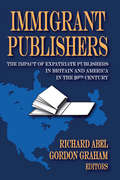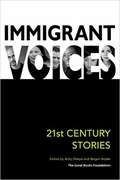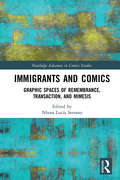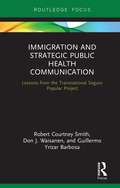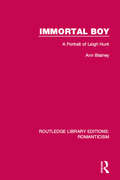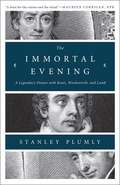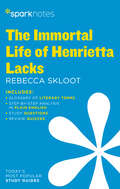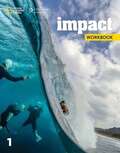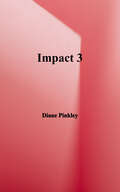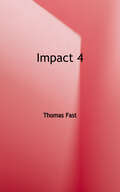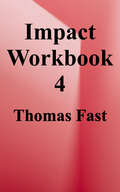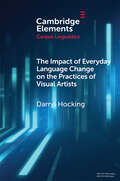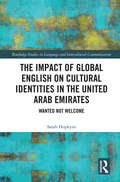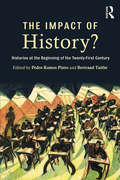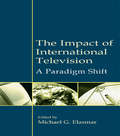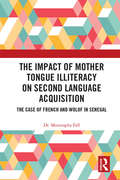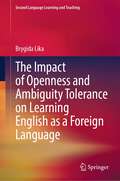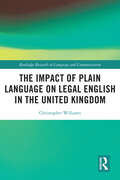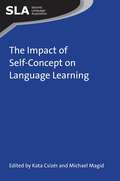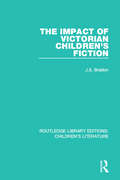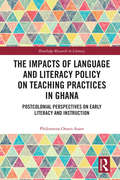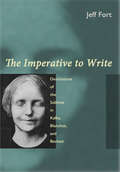- Table View
- List View
Immigrant Publishers: The Impact of Expatriate Publishers in Britain and America in the 20th Century
by Richard Abel and Cordon GrahamIn the first third of the twentieth century, the publishing industry in the United Kingdom and the United States was marked by well-established and comfortable traditions pursued by family-dominated firms. The British trade was the preserve of self-satisfied men entirely certain of their superiority in the world of letters; their counterparts in North America were blissfully unaware of development and trends outside their borders. In this unique historical analysis, Richard Abel and Gordon Graham show how publishing evolved post-World War II to embrace a different, more culturally inclusive, vision.Unfortunately, even among the learned classes, only a handful clearly understood either the nature or the likely consequences of the mounting geopolitical tensions that gripped pre-war Europe. The world was largely caught up in the ill-informed and unexamined but widely held smug and shallow belief that the huge price paid in "the war to end all wars" had purchased perpetual peace, a peace to be maintained by the numerous, post-war high-minded treaties ceremoniously signed thereafter.The history presented here has as its principals a handful of those who fled to the Anglo-Saxon shores in the pre-World War II era. The remainder made their way to Britain and the United States following that war. They brought an entirely new vision of and energetic pursuit of the cultural role of the book and journal in a society, a vision which was quickly adopted and naturalized by a perspicacious band of post-war native-born book people.
Immigrant Voices: 21st Century Stories
by Great StaffThe eighteen stories collected in Immigrant Voices highlight the complex relationships of immigrants in the United States at the beginning of the twenty-first century with their families, friends, new surroundings, and home countries. The authors themselves have made many of the same kinds of transitions as the characters they portray, and they offer fresh perspectives on the immigrant experience. Coedited by award-winning author Achy Obejas and cultural studies scholar Megan Bayles, this anthology addresses the perennial questions about society and the individual that the authors of the Great Books have pondered for centuries.
Immigrants and Comics: Graphic Spaces of Remembrance, Transaction, and Mimesis (Routledge Advances in Comics Studies)
by Nhora Lucía SerranoImmigrants and Comics is an interdisciplinary, themed anthology that focuses on how comics have played a crucial role in representing, constructing, and reifying the immigrant subject and the immigrant experience in popular global culture of the twentieth and twenty-first centuries. Nhora Lucía Serrano and a diverse group of contributors examine immigrant experience as they navigate new socio-political milieux in cartoons, comics, and graphic novels across cultures and time periods. They interrogate how immigration is portrayed in comics and how the ‘immigrant’ was an indispensable and vital trope to the development of the comics medium in the twentieth century. At the heart of the book‘s interdisciplinary nexus is a critical framework steeped in the ideas of remembrance and commemoration, what Pierre Nora calls lieux de mémoire. This book will be of interest to students and scholars in Visual Studies, Comparative Literature, English, Ethnic Studies, Francophone Studies, American Studies, Hispanic Studies, art history, and museum studies.
Immigrants of Yesterday and Today: Leveled Reader Grade 6. 5. 2 (Reading Street)
by Mary DismasThe final installment of the Reading Street curriculum series, Reading Street: Grade 6, comes complete with everything you'll need to create English and Language Arts lessons for your child. This system includes reading selections designed to help your child hone his or her skills, a Teacher Resource DVD to make your task of developing lessons easier, and a packet of curriculum materials. <P><P>Reading Street: Grade 6 is a comprehensive system designed to enhance your child's skills in reading, writing and language. Each assignment in Reading Street helps your child progress toward that goal. While such a dynamic curriculum might sound challenging for you as a parent and educator to use, you can rest assured that the materials will guide you through 12 weeks of English and Language Arts lesson planning with ease.
Immigration and Strategic Public Health Communication: Lessons from the Transnational Seguro Popular Project (Routledge Research in Health Communication)
by Robert Smith Don Waisanen Guillermo Yrizar BarbosaThis book engages a key question facing governments and similar institutions in countries of immigration or emigration: how should these governments and institutions communicate with immigrants so that they will listen to and act on their messages? Drawing on original research with Mexican emigrants in New York and the Mexican government’s Seguro Popular health care program, the authors examine the ways in which governments integrate migrants into diasporic political, medical, educational, and other systems, and how migrant-sending countries communicate with their emigrants abroad. In analyzing how these efforts fail or succeed, this book presents strategies and policy recommendations that many governments and institutions can use to engage their citizens or clients ethically and effectively. Offering a valuable approach to the study of race, migration, and public policy, this book will be of key importance to researchers and graduate students in public health, sociology, marketing and business, political science, Latinx studies, and international communication.
Immortal Boy: A Portrait of Leigh Hunt (Routledge Library Editions: Romanticism #4)
by Ann BlaineyAnn Blainey’s work, first published in 1985, provides a sensitive study of Leigh Hunt and the literary climate that influenced his life, and fills a large gap in literary biography. Blainey brings a perceptive eye to a generally embittered man whose chaotic life seemed a tragic failure. This title will be of interest to students of literature.
The Immortal Evening: A Legendary Dinner with Keats, Wordsworth, and Lamb
by Stanley PlumlyA window onto the lives of the Romantic poets through the re-creation of one legendary night in 1817. The author of the highly acclaimed Posthumous Keats, praised as "full of . . . those fleeting moments we call genius" (Washington Post), now provides a window into the lives of Keats and his contemporaries in this brilliant new work. On December 28, 1817, the painter Benjamin Robert Haydon hosted what he referred to in his diaries and autobiography as the "immortal dinner." He wanted to introduce his young friend John Keats to the great William Wordsworth and to celebrate with his friends his most important historical painting thus far, "Christ's Entry into Jerusalem," in which Keats, Wordsworth, and Charles Lamb (also a guest at the party) appeared. After thoughtful and entertaining discussions of poetry and art and their relation to Enlightenment science, the party evolved into a lively, raucous evening. This legendary event would prove to be a highlight in the lives of these immortals. A beautiful and profound work of extraordinary brilliance, The Immortal Evening regards the dinner as a lens through which to understand the lives and work of these legendary artists and to contemplate the immortality of genius.
The Immortal Life of Henrietta Lacks SparkNotes Literature Guide (SparkNotes Literature Guide Series)
by SparkNotesCreated by Harvard students for students everywhere, SparkNotes give you just what you need to succeed in school: Complete Plot Summary and AnalysisKey Facts About the WorkAnalysis of Major CharactersThemes, Motifs, and SymbolsExplanation of Important QuotationsAuthor&’s Historical ContextSuggested Essay Topics25-Question Review QuizThe Immortal Life of Henrietta Lacks features explanations of key themes, motifs, and symbols including: humanity; immortality and legacy; scientific racism; racialized poverty; hela cells; red nail polish. It also includes detailed analysis of these important characters: Deborah Lacks; Henrietta Lacks; Rebecca Skloot; George Gey.
Immunity's Sovereignty and Eighteenth- and Nineteenth-Century American Literature (Pivotal Studies in the Global American Literary Imagination)
by Rick RodriguezImmunity’s Sovereignty and Eighteenth- and Nineteenth-Century American Literature tracks flashpoint events in U.S. history, constituting a genealogy of the effectiveness and resilience of the concept of immunity in democratic culture. Rick Rodriguez argues that following the American Revolution the former colonies found themselves subject to foreign and domestic threats imperiling their independence. Wars with North African regencies, responses to the Haitian revolution, reactions to the specter and reality of slave rebellion in the antebellum South, and plans to acquire Cuba to ease tensions between the states all constituted immunizing responses that helped define the conceptual and aesthetic protocols by which the U.S. represented itself to itself and to the world’s nations as distinct, exemplary, and vulnerable. Rodriguez examines these events as expressions of an immunitary logic that was—and still is— frequently deployed to legitimate state authority. Rodriguez identifies contradictions in literary texts’ dramatizations of these transnational events and their attending threats, revealing how democracy’s exposure to its own fragility serves as rationale for immunity’s sovereignty. This book shows how early U.S. literature, often conceived as a delivery system for American exceptionalism, is in effect critical of such immunitary discourses.
Impact 3
by Diane PinkleyThis book helps teenage learners to better understand themselves, each other, and the world they live in. By encouraging self-expression, global citizenship, and active participation, the book motivates students to explore who they are and who they want to be, all while learning English!
Impact 4
by Thomas FastImpact helps teenage learners to better understand themselves, each other, and the world they live in. By encouraging self-expression, global citizenship, and active participation, Impact motivates students to explore who they are and who they want to be, all while learning English!
Impact 4: Workbook
by Thomas FastImpact helps teenage learners better understand themselves, each other, and the world they live in. By encouraging self-expression, global citizenship, and active participation, impact motivates students to explore who they are and who they want to be - all while learning english the impact workbook contains activies that reinforce and consolidate the content of the student book, and includes listening, reading, writing, grammar, and vocabulary practice. The impact workbook includes - 10 pages of language practice, activities, and an additional reading for each unit. - now I can self-assessment sections, giving learners an opportunity to reflect on what they have learned and identify areas where they need additional practice. - review sections, featuring question types commonly found on standardized exams. - additional student-choice activities, providing opportunities for targeted skills practice. Impact helps teenage learners better understand themselves, each other, and the world they live in. By encouraging self-expression, global citizenship, and active participation, impact motivates students to explore who they are and who they want to be - all while learning english the impact workbook contains activies that reinforce and consolidate the content of the student book, and includes listening, reading, writing, grammar, and vocabulary practice. The impact workbook includes - 10 pages of language practice, activities, and an additional reading for each unit. - now I can self-assessment sections, giving learners an opportunity to reflect on what they have learned and identify areas where they need additional practice. - review sections, featuring question types commonly found on standardized exams. - additional student-choice activities, providing opportunities for targeted skills practice.
The Impact of Everyday Language Change on the Practices of Visual Artists (Elements in Corpus Linguistics)
by Darryl HockingThe practices of visual artists can never be decontextualised from language. Firstly, artists are constantly in dialogue with their peers, dealers, critics, and audiences about their creative activities and these interactions impact on the work they produce. Secondly, artists' conceptualisations of what artistic practice encompasses are always shaped by wider social discourses. These discourses, however, and their manifestation in the language of everyday life are subject to continual change, and potentially reshape the way that artists conceptualise their practices. Using a 235,000-word diachronic corpus developed from artists' interviews and statements, this Element investigates shifts in artists' use of language to conceptualise their art practice from 1950 to 2019. It then compares these shifts to see if they align with changes in the wider English lexicon and whether there might be a relationship between everyday language change and the aesthetic and conceptual developments that take place in the art world.
The Impact of Global English on Cultural Identities in the United Arab Emirates: Wanted not Welcome (Routledge Studies in Language and Intercultural Communication)
by Sarah HopkynsThis book provides a nuanced portrait of the complexities of the cultural and linguistic landscape in the United Arab Emirates, unpacking the ever shifting dynamics and attitudes between and about English and Arabic in the region in today’s era of superdiversity.// Employing a qualitative phenomenological approach which draws on a rich set of data from questionnaires and focus groups comprising both Emirati and expatriate students and teachers, Hopkyns problematizes the common binary East-West paradigm focused around the tension between the use of English and Arabic in the UAE. Key issues emerging from the resulting analysis include the differing attitudes toward English and in particular, English Medium Instruction, the impact of this tension on identity, and the ways in which the two languages are employed in distinct ways on an everyday scale. // The volume will be of particular interest to students and scholars interested in issues around language and identity, language policy and planning, multilingualism, translanguaging, and language and education.
The Impact of History?: Histories at the Beginning of the 21st Century
by Pedro Ramos Pinto Bertrand TaitheDriven by the increasing importance of discussions around 'impact' and its meaning and implications for history, The Impact of History? brings together established and new voices to raise relevant questions, issues and controversies for debate. The chapters are articulated around the themes of public history, the politics of history, the role of history in the shaping of learning and the situation of history in the changing world of education. While this subject is driven differently by the research bodies and councils of different countries, similar debates about the value and place of the academy in society are taking place in the UK, the USA and Europe as well as in other parts of the world. Chapters cover diverse areas of history from this perspective including: public history national histories new technologies and the natural sciences campaigning histories the impact agenda. This collection is a political and intellectual intervention at a time when scholars and readers of history are being asked to explain why history matters and it seeks to intervene in the debates on ‘impact’, on education and on the role of the past in the shaping of our future. Bringing together leading authors from a wide range of fields, The Impact of History? is an accessible and engaging yet polemical and thought-provoking overview of the role of history in contemporary society.
The Impact of International Television: A Paradigm Shift (Routledge Communication Series)
by Michael G. ElasmarFor several decades, cultural imperialism has been the dominant paradigm for conceptualizing, labeling, predicting, and explaining the effects of international television. It has been used as an unchallenged premise for numerous essays on the topic of imported television influence, despite the fact that the assumption of strong cultural influence is not necessarily reflected in the body of research that exists within this field of study. In The Impact of International Television: A Paradigm Shift, editor Michael G. Elasmar and his contributors challenge the dominant paradigm of cultural imperialism, and offer an alternative paradigm with which to evaluate international or crossborder message influence. In this volume, Elasmar has collected original research from leading scholars working in the area of crossborder media influence, and contributes his own meta-analysis to examine what research findings actually show on the influences of crossborder messages. The contributions included here illustrate points, such as: the contentions of cultural imperialism and the context in which its assumptions emerged and developed; the complexities of the relationship between exposure to foreign television and its subsequent effects on local audience members; the applicability of quantitative methods to a topic commonly tackled using argumentation, critical theory, and other qualitative approaches; and the difficulty of achieving strong and homogenous effects. In bringing together the work of independent researchers, The Impact of International Television: A Paradigm Shift bridges over 40 years of research efforts focused on imported television influence, the results of which, as a whole, challenge the de facto strong and homogenous effects assumed by those who support the paradigm of cultural imperialism. The volume sets a theory-driven agenda of research and offers an alternative paradigm for the new generation of researchers interested in international media effects. As such, the volume is intended for scholars, researchers, and students in international and intercultural communication, cross-cultural communication, mass communication, media effects, media and society, and related areas. It will also be of great interest to academics in international relations, cross-cultural and social psychology, intergroup and international relations, international public opinion, and peace studies.
The Impact of Mother Tongue Illiteracy on Second Language Acquisition: The Case of French and Wolof in Senegal (Routledge Research in Language Education)
by Moustapha FallThis text illustrates the crucial role of the mother tongue literacy in second language acquisition by presenting findings from a comparative study conducted in primary schools in Senegal. In addition, the volume provides an in-depth look at the linguistic history of Senegal before, during, and after French colonialism. The Impact of Mother Tongue Illiteracy on Second Language Acquisition discusses the socio-linguistic landscape and ethnolinguistic composition of Senegal and its effect on the second language acquisition. An in-depth analysis of children’s phonological awareness, decoding, and reading comprehension in French reveals significant disparities in the literacy skills of Wolof children who have been exposed to Arabic and Qur’anic texts prior to schooling, and those who have not. In doing so, the text explores the impacts of post-colonial language policies in Africa, highlights the pedagogical consequences of mother tongue illiteracy, and questions the use of French as the only language of instruction in Senegalese schools. This detailed research text will of great interest and use to graduate and postgraduate students, researchers, academics, professionals and policy makers in the field of Second Language Acquisition, Multicultural Education, Applied Linguistics, French language education and, Language Policy and Planning.
The Impact of Openness and Ambiguity Tolerance on Learning English as a Foreign Language (Second Language Learning and Teaching)
by Brygida LikaThis book highlights the importance of individual learner differences in learning English as a foreign language and reports the findings of a study which investigated the impact of two personality traits, which are, openness to experience and ambiguity tolerance, on target language attainment among Polish secondary school students. The book provides an exhaustive overview of the theoretical issues and existing research related to personality, emphasizing the two traits under investigation, openness, and ambiguity tolerance, which are the focus of the empirical study reported later in the book. The empirical investigation explored relationships between openness to experience and ambiguity tolerance, as well as their impact on attainment in learning English as a foreign language. Moreover, it also aimed to shed light on the link between these traits and students’ assessments (i.e., self-assessment and school grades). The findings of the study provide a basis for proposing specific profiles of foreign language learners with different levels of openness and ambiguity tolerance.
The Impact of Plain Language on Legal English in the United Kingdom (Routledge Research in Language and Communication)
by Christopher WilliamsThis volume offers insights into the ways in which plain language has influenced the language of the law in the United Kingdom, critically reflecting on its historical development and future directions. The book opens with an overview of the theoretical frameworks underpinning plain language and a brief history of plain language initiatives as a foundation from which to outline ongoing debates on the opportunities and challenges of using plain language in the legal domain. The volume details strands where plain language has had considerable impact thus far on legal English in the UK, notably in legislative drafting, but it also explores areas in which plain language has made fewer inroads, such as the language of court judgments and that of online terms and conditions. The book looks ahead to unpack highly topical areas within the plain language debate, including the question of design and visualisation and the ramifications of digitalisation, contributing to ongoing conversations on the importance of plain language both in the UK and beyond. This book will be of particular interest to students and scholars interested in the intersection of language and the law as well as related disciplinary areas such as applied linguistics and English for Specific Purposes.
The Impact of Self-Concept on Language Learning
by Kata Csizér Michael MagidThis edited volume seeks to highlight the effects of self-concept on L2 learning and teaching by considering a wide range of theories as well as their practical application. The book is divided into four sections and includes: chapters discussing various approaches related to self-concept; empirical studies related to the selves of the learners; research from teachers' perspectives on students' self-concept; and L2 motivational intervention studies associated with the development of self-concept of language learners. The volume contains a collection of studies from around the world (Central Europe, Canada, Asia and Australia) which were carried out using a variety of research methods and have a range of foci including adult and young learners, public and private education, foreign and second language settings, and teacher and learner motivation.
The Impact of Victorian Children's Fiction (Routledge Library Editions: Children's Literature #1)
by J. S. BrattonOriginally published in 1981. Many of the classics of children’s literature were produced in the Victorian period. But Alice in Wonderland and The King of the Golden River were not the books offered to the majority of children of the time. When writing for children began to be taken seriously, it was not as an art, but as an instrument of moral suasion, practical instruction, Christian propaganda or social control. This book describes and evaluates this body of literature. It places the books in the economic and social contexts of their writing and publication, and considers many of the most prolific writers in detail. It deals with the stories intended to teach the newly-literate poor their social and religious lessons: sensational romances, tales of adventure and military glory, through which the boys were taught the value of self-help and inspired with the ideals of empire; and domestic novels, intended to offer girls a model for the expression of heroism and aspiration within the restricted Victorian woman’s world.
The Impacts of Language and Literacy Policy on Teaching Practices in Ghana: Postcolonial Perspectives on Early Literacy and Instruction (Routledge Research in Literacy)
by Philomena Osseo-AsareThis text critically examines changes in Ghanaian language and literacy policy following independence in 1957 to consider its impacts on early literacy teaching. By adopting a postcolonial theoretical perspective, the text interrogates the logic behind policy changes which have prioritised English, local language, or biliteracy. It draws on data from interviews with teachers and researcher observation to demonstrate how policies have influenced teaching and learning. Dr Osseo-Asare’s findings inform the development of a conceptual framework which highlights the socio-cultural factors that impact the literacy and biliteracy of young children in Ghana, offering solutions to help teachers combat the challenges of frequent policy changes. This timely monograph will prove to be an essential resource not only for researchers working on education policies, teacher education, and English-language learning in postcolonial Ghana but also for those looking to identify the thematic and methodological nuances of studying literacy and education in postcolonial contexts.
The Imperative to Write: Destitutions of the Sublime in Kafka, Blanchot, and Beckett
by Jeff FortIs writing haunted by a categorical imperative? Does the Kantian sublime continue to shape the writer’s vocation, even for twentieth-century authors? What precise shape, form, or figure does this residue of sublimity take in the fictions that follow from it—and that leave it in ruins?This book explores these questions through readings of three authors who bear witness to an ambiguous exigency: writing as a demanding and exclusive task, at odds with life, but also a mere compulsion, a drive without end or reason, even a kind of torture. If Kafka, Blanchot, and Beckett mimic a sublime vocation in their extreme devotion to writing, they do so in full awareness that the trajectory it dictates leads not to metaphysical redemption but rather downward, into the uncanny element of fiction. As this book argues, the sublime has always been a deeply melancholy affair, even in its classical Kantian form, but it is in the attenuated speech of narrative voices progressively stripped of their resources and rewards that the true nature of this melancholy is revealed.
